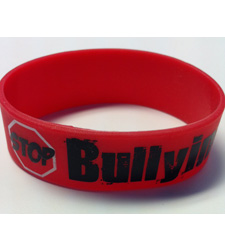By Hessie Jones
Bullies have always existed. When I was growing up, the bullying many kids experienced was relegated to our physical spaces: an inappropriate note in our desk, hurtful comments, or physical contact in the schoolyard, in the bus, at a party, or near our home.

Bullying Awareness Week is a chance not to "leave it to someone else."
For many kids, the experience was mentally and physically agonizing. But the experience was confined to a few kids, and a defined time period. Hopefully, for most of us, it eventually stopped. The bully forgot about “me” and moved on to the next victim. We have all lived through it and survived it.
The week of November 14th- 18th is Bullying Awareness Week. This is an opportunity for people at the grassroots level in communities around the world to get involved in this issue, not by waiting for “Someone else” to do something, but rather for us to work together on preventing bullying in our communities through education and awareness. Please go to Bullying Awareness Week for details.
The world of bullying has changed since I was a child. The Internet has brought bullying to a new level––one with enduring repercussions:
- The bullying has corralled the voyeurs: ie. witnesses to the experience who may or may not be related to the offending or offended parties. These are the ‘friends or ‘friends of friends’ on Facebook. The implications of this now elicits the viral spread of the incident.
- The victim is now the centre of attention for all to see: exposed to the malicious comments, or pictures and afraid of defending or responding for fear of further attacks. The home, which once was a safe haven from bullying, cannot be called that today. There’s no escape from it.
- While the physical violence exists offline, the social footprint made by every comment is there to stay…forever and that’s what makes today’s definition of bullying more painful for young kids.
Take the case earlier this year of the 15 year-old girl from Nova Scotia, who was tormented when someone created a fake Facebook account using her photo and “other identifying information”. The bullies tortured her about her weight, her appearance and even “used scandalous sexual commentary that was private and intimate.” The offending party was eventually found out, however through this ordeal, the 15-year-old just wanted the incident to go away and asked that her identity and content be kept from publication. It is currently before the Supreme Court of Canada.
The Huffington Post recently reported that 56% of teens and those in their early 20s have ” been the target of some type of online taunting, harassment or bullying“. This is increasing year over year. What makes this more disturbing is the increasing use of mobile devices to perpetuate the taunting: “sexting” and sharing of offensive pictures or video.
It’s clear that online and mobile communication continue to rise with this demographic. Comscore recently reported “Young people are simply spending more time social networking than anything else, up 3.8% to 14.% of all time spent online.” And that’s what makes cyberbullying all the more dangerous. Groupthink online and through mobile devices not only affects a person’s reputation, it also impacts their mental stability and eventually their life.
The other day, I heard about a teacher who created a strong analogy of bullying to her students to bring home the stigma attached to it. She noted that bullying was like taking a piece of paper and crumpling it up and then trying to flatten it out again. The crumpled lines are difficult to remove and this represents the emotional scars that remain long after the bullying has ended. They will never go away. It’s nice to know that this type of education is happening in the classroom. It begins with the kids.
My daughter asked me if she could purchase this bracelet while we were at her book fair just last week. She said all the kids were wearing it. This put a smile on my face. The message is hitting the young kids and they are speaking about it.
I also saw a few Facebook Pages that had strong following: End Cyberbullying has over 128,000 Likes. I like the message that this page offers, “Sometimes it’s really hard to tell the difference between cyberbullying and harmless fun – it can be really easy to send on stuff without thinking about how seriously it could affect someone’s life…So what do you think? Have your say in the discussions area and see how you can make a difference to cyberbullying behaviour.” The great thing: while Facebook is a haven for the perpetrators, it is equally a haven for kids to speak out in forums where their voices are heard and acknowledged.

Members of the Facebook page "No More Bullies" pledge support with images.
This Facebook Page, “No More Bullies” uses strong images to support its cause. And these are generated from all generations alike:While it only has about 1530 Likes, more than 800 have engaged in the cause:
The only way to raise awareness of cyberbullying, is to use the very mediums that have perpetuated this, and extinguish its flame. It also starts with the kids. My daughter was cyberbullied by another student, who proceeded to put up a video denouncing my daughter. It left her in shock and wondering what she did to deserve this. Thankfully, the incident was short-lived. But maybe the broader strength of those against this plight will be enough to quell and eventually obliterate the bullies. This will be ever important as technology continues to influence communication at even faster rates.
- More about Hessie Jones
- A decade of cyberbullying – and what we can do about it




Thank you so much for your comments. This has brought so much more context to what I have written. I do not purport to assume what you or any other victim has experienced. And you are so right when you say that the home is not a safe haven — perhaps a temporary relief from the direct onslaught. Emotionally, the home cannot cure the anguish, fear and anxiety that comes with being a victim. And it would scare me to think that the anonymity of the Internet brings out behaviors in us that are unbecoming in person. I would hope that’s not the case. If it is, the more reason to stop it before it runs rampant. Your post has brought so much more meaning to this cause. Thank you for sharing!
Dear Mrs. Jones,
I find it difficult to write this, as I’m sure your article is well intentioned. I really don’t mean to offend, nor discourage you from writing what is on your mind. But, as the victim of a great deal of bullying in my time, I have to say that your attempt to minimize the non-cyber flavor of bullying is rather frustrating.
Your attempt to expand the scope of cyberbullying as a very public, somehow implies that being beaten and spit upon in the middle of schoolyard of 300+ students is somehow a private event. It isn’t. And some onlookers can be just as cruel as the bullies.
You say that home was a safe place from physical and emotional bullying. It isn’t. Try sleeping while in the deep chill of the tortured anticipation of tomorrow’s beatings, and tell me you feel safe. That’s like implying that turning off the computer cures cyberbullying.
As for a lasting social footprint, that’s highly arguable. (Although, in the absence of scientific data, I’m not sure that arguments in either direction are fruitful.) True, traces may exist in years to come. However, the ever expanding volume of the global social network will eventually dilute the acid stained postings of bullies. If I do a very precise Google search, I can find things that I wrote on the Internet as a ten year old child in 1995. But I REALLY have to know where to look. Eventually, you can only find what you remember is there in the first place. This suggests the possibility that cybperbullying is little more enduring than the memories of the victims, which was the case with plain old vanilla bullying.
I think one of the most significant differences between cyberbullying and bully-classic is the layer of abstraction that it affords the perpetrators. We all say things behind the wheel that we would never say to the other driver’s face. We write email containing words and phrases that we wouldn’t dare use in person. Somehow, the accountability of being physically observed by others disarms us. Does this open the door for people to become cyberbullies who never would have been regular bullies? I certainly don’t know, and I’d leave that to the social scientists. That may be good advise in general.
I’d like to say again though, that I’m sure your article is written with the best of intentions and I really don’t wish to offend. I’m just expressing some frustration over having my childhood experiences minimized. I think there is a complete lack of a scientific basis to imply that cyberbullying is any more or less damaging than non-cyber equivalents. I am glad though, that people are rallying to stop bullying in any form. Thank you for the post.